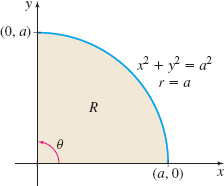EXAMPLE 3Finding a Double Integral Using Polar Coordinates
Find \(\displaystyle\iint\limits_{\kern-3ptR}e^{x^{2}+y^{2}}\,d\!A\), where \(R\) is the region in the first quadrant inside the circle \(x^{2}+y^{2}=a^{2}\).

Figure 28 \(0\leq r\leq a,\) \(0\leq \theta \leq \dfrac{\pi }{2}\)
Solution In rectangular coordinates, \(\iint \limits_{\kern-3ptR}e^{x^{2}+y^{2}}\,d\!A\) only can be approximated using numerical techniques. But the presence of \(x^{2}+y^{2}\) in the integrand and the fact that the region \(R\) has part of a circle as its boundary suggest using polar coordinates. Figure 28 shows the region \(R.\) We use polar coordinates to obtain 